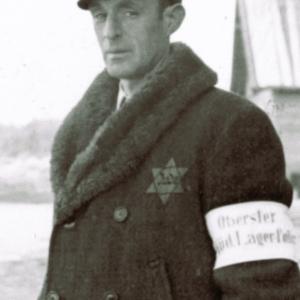
Kapos
In the Nazi concentration camp system, a kapo was a prisoner placed in authority over other prisoners. The German term used by the SS was Funktionshäftling, meaning “functionary prisoner.” These functionaries supervised work details, kept order in the barracks, distributed food, and carried out many of the daily operations that kept camps like Auschwitz, Dachau, Mauthausen, Buchenwald, and others running. In exchange, kapos received slightly better food, warmer clothing, and a small degree of protection from random SS brutality. These advantages were often the difference between life and death.
Kapos were not SS guards; they remained inmates and lived under constant threat. In the early camp years, the SS mainly selected kapos from criminal prisoners they believed could be ruthless enforcers. As the war expanded and millions of Jews were deported, Jewish prisoners were also forced into these roles. This system was deliberately designed to break solidarity among prisoners by making them police one another, ensuring that survival itself carried moral cost.
The daily work of a kapo varied. Some acted as block elders, controlling barracks life, food distribution, sleeping assignments, and discipline. Others supervised labour groups in quarries, workshops, factories, and construction areas. In Auschwitz, kapos marched their labour commandos to work sites, enforced pace and order, and decided who might be given slightly less lethal tasks. In a world of exhaustion, starvation, and disease, these decisions could determine who lived and who died.
Violence was built into the job. The SS expected kapos to maintain control with intimidation, beatings, and cruelty. A kapo who showed too much compassion risked being demoted, returned to deadly labour, or killed outright—quickly replaced by someone more brutal. As a result, many kapos became feared figures remembered by survivors for harshness or sadism. Yet the picture was not entirely uniform. Some kapos, especially those in clerical or medical roles, quietly bent the rules to protect weaker prisoners, hide the sick, smuggle food, or falsify lists to keep people from being selected for death. These acts were dangerous, and the boundary between survival and complicity was painfully narrow.
Whether kapos “volunteered” is a complex question. Many prisoners sought any role that offered a marginal increase in survival. Accepting such a position might appear voluntary, but the coercive environment meant refusing could mean death. Once appointed, a kapo who refused orders faced lethal consequences. Some embraced their power; others accepted the role grudgingly, simply trying to survive another day. This ambiguous space is often described as the grey zone of the camps, where victim and perpetrator blurred under extreme duress.
At liberation, resentment toward kapos ran deep. In several camps, as the SS fled and authority collapsed, survivors turned on the most brutal functionaries. Some were beaten or lynched in spontaneous acts of revenge. Elsewhere, former kapos were ostracized and despised by fellow survivors who associated them with suffering and humiliation.
After the war, some kapos were put on trial. Courts in Poland, Germany, and later Israel prosecuted individuals accused of extreme cruelty. Jewish communities in displaced-persons camps also held honour courts to judge fellow Jews who served as kapos or in other administrative roles under Nazi rule. These trials and hearings were emotionally charged because they forced survivors to confront the behaviour of people who, like them, had lived through unimaginable conditions. Verdicts varied, reflecting the complexity of judging actions committed within a system built entirely on terror.
In survivor writings, films, and historical studies, kapos often stand as symbols of the moral chaos inside the camps. They represent the impossible choices forced on prisoners—choices shaped by desperation, coercion, corrupted authority, and the will to survive. While some functionaries became notorious for cruelty, others resisted in small, quiet ways that helped save lives.
Understanding the role of the kapo—of the Funktionshäftling—is not about justifying what any individual did. It is about recognising how the Nazis engineered a system that compelled prisoners to participate in their own oppression.










